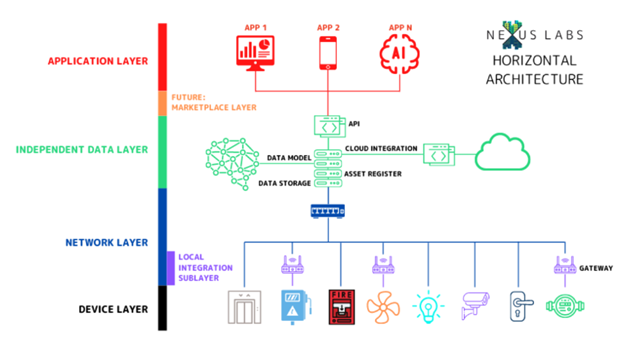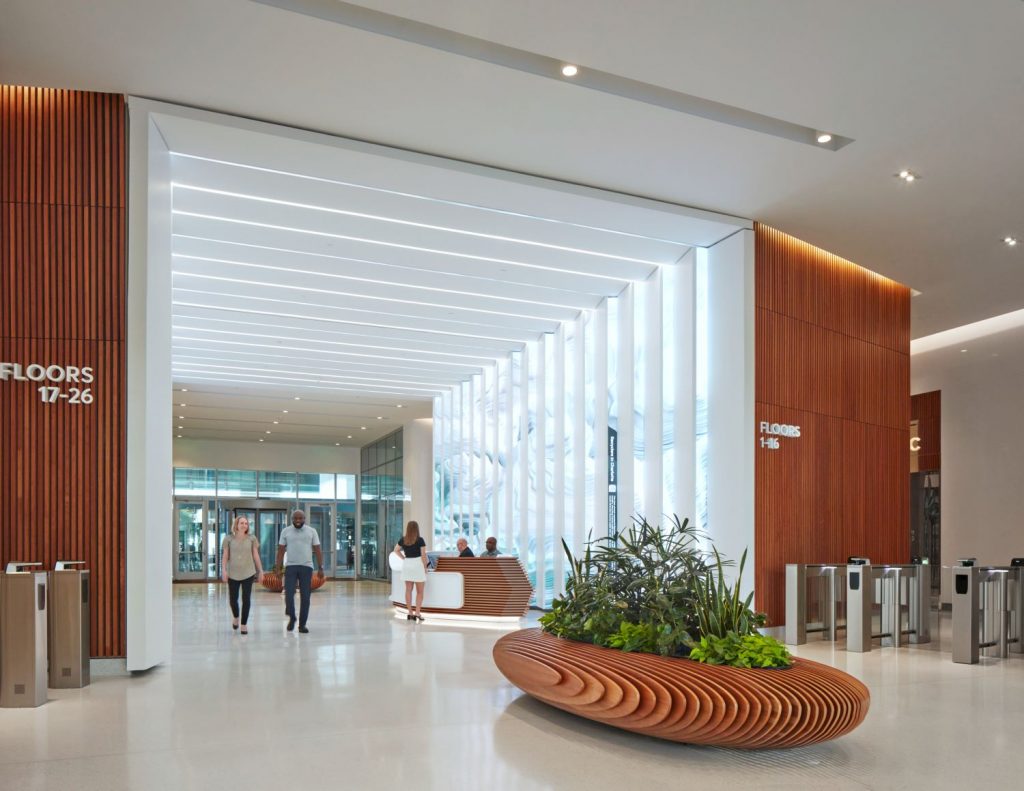Director of Little’s Smart Building Studio, David Stephenson, offers the ways in which smart buildings can last in the ever-evolving workplace.
Buildings have undergone significant advancements since the once futuristic office spaces of the 1980s, becoming more sophisticated and interconnected. These improvements have primarily been focused on enhancing operations by optimizing energy usage and extending the lifespan of building assets. In the 1990s, technology deployment was typically limited to individual buildings and concentrated on HVAC and lighting controls. However, operators rarely integrated these systems into a unified platform that could be managed remotely.
Fast forward to today and our buildings have transformed into highly evolved entities. Modern smart buildings are equipped with an array of sensors that continuously monitor various parameters such as temperature, light, noise, occupancy, vibrations and air quality. Seamlessly integrated, these sensors not only enhance operational efficiency but also elevate the overall experience for building occupants.

While these developments are exciting, there are still significant challenges in delivering a fully integrated smart building to support the office of the future. Historically, building operations technology has not been managed and implemented in the same way as a corporate IT network. Here are key hurdles to achieving smart building technology integration:
- Siloed Applications: Building systems often operate in isolation, with disparate applications that rely on different programming languages. This lack of integration hinders seamless communication and data sharing.
- Vendor Lock-In: Building operators frequently find themselves locked into single vendor ecosystems. This limitation restricts flexibility and interoperability, making it difficult to mix-and-match solutions from different providers.
- Retrofitting Complexity: Upgrading an existing building to smart technology is a costly and time-consuming process. Retrofitting involves integrating new systems with legacy infrastructure, which can be logistically challenging.
- New vs. Existing Buildings: While advancements are more straightforward in new constructions, retrofitting existing buildings remains a complex endeavor. As a result, smart building innovations are often more prevalent in new structures.
Addressing these challenges requires collaboration, standardization and a strategic approach to ensure that smart buildings truly live up to their potential.
The Smart Building Tech Stack
A smart building is made up of multiple layers containing devices and sensors, software platforms, networks and data sources. When building a Smart Building Tech Stack, developing a strategy to address how these layers will be integrated and managed is the first step any organization should take. The four primary layers in a smart building are:
- Device Layer: The device layer contains the edge devices that collect building environment data such as temperature, air quality, noise, light levels, occupancy, etc.
- Network Layer: The network layer provides the connections between devices as well as between devices and the cloud and allows remote access for administrators.
- Independent Data Layer: The independent data layer provides the repository where information is normalized for analysis and use by applications in the application layer.
- Application Layer: The application layer contains user-facing applications that provide analysis results and support use cases for end users, such as booking a conference room or hoteling desk.

Staffing the Smart Building Strategy
In addition to developing the necessary technology stack, a successful smart building strategy must involve a well-rounded mix of participants who possess the expertise to construct and manage each layer. Historically, IT departments have not actively participated in the installation and administration of building automation systems. In many cases, they remain unaware that computers within the building are accessible to external vendors using common username-password combinations. To foster a secure networked ecosystem of devices and applications, this paradigm needs to shift.
As the number of devices proliferates, cybersecurity becomes a critical activity. For example, ensuring that bad actors cannot compromise access control systems and potentially lock occupants in or out of the building is paramount. By fostering collaboration between IT professionals and building operators, we can create a robust and secure smart building environment.

Beyond IT and building operators, other crucial roles including design engineers, commissioning experts and master systems integrators contribute significantly to a fully integrated smart building. Merely relying on a building automation vendor and the Facility Manager is not enough; realizing a smart building’s potential requires orchestrating a symphony of expertise to create a seamless, efficient, safe environment for all occupants.
The Office of the Future
Smart buildings offer a plethora of valuable and intriguing use cases, but for now, let’s narrow our focus to the office environment. As companies grapple with the challenge of enticing employees back to traditional office spaces, there’s a compelling solution: enhancing the overall office experience. By leveraging technology and thoughtful strategies, we can create purposeful and effective office visits. Here are some key use cases to encourage a return to the office:
- Mobile Desk Booking: Imagine a seamless process where employees can reserve desks in real-time using a space management platform. Whether it’s a quiet corner or a collaborative area, this feature ensures that employees find a suitable workspace for the day. [See Work Design’s roundup of options here]
- In-person Collaboration: Collaboration lies at the heart of productivity. With a workplace experience app, employees can form “collaboration groups.” When a team member books a desk in the office, others receive a nudge to do the same. This interactivity fosters spontaneous socialization and teamwork.
- Corporate Communication Integration: Regardless of where employees choose to work—whether at home, in a coffee shop, or within the office—the app becomes a hub for corporate announcements, news and events. Keeping employees engaged and informed is essential, and this feature achieves just that.
- Environmental Insights: Armed with data, employees can make informed decisions about their work environment. The app provides real-time information on indoor air quality, noise levels, and occupant density. Need a quiet space for focused work? Want to join a lively brainstorming session? Now you can decide based on accurate information.
In a nutshell, smart buildings offer boundless potential for revolutionizing the office experience. By embracing the outlined use cases, organizations can cultivate an environment that seamlessly blends invitation and efficiency, ultimately benefiting both employees and the organization at large.
To achieve this integration, smart building teams must adopt a strategic tech stack that thoughtfully segregates its various layers. But it doesn’t end there.
Building a diverse team of experts — design engineers, commissioning specialists and master systems integrators — is pivotal. Each role contributes to the symphony of innovation. Clearly defined responsibilities ensure stability and pave the way for truly transformative environments.
In this collaborative dance of technology and expertise, smart buildings evolve, adapt and thrive — ready to meet the ever-changing demands of the market and the exciting use cases yet to unfold.
Want to learn more about smart buildings? Check out:
PropTech for People: Engaging Your Workforce with Smart Buildings


